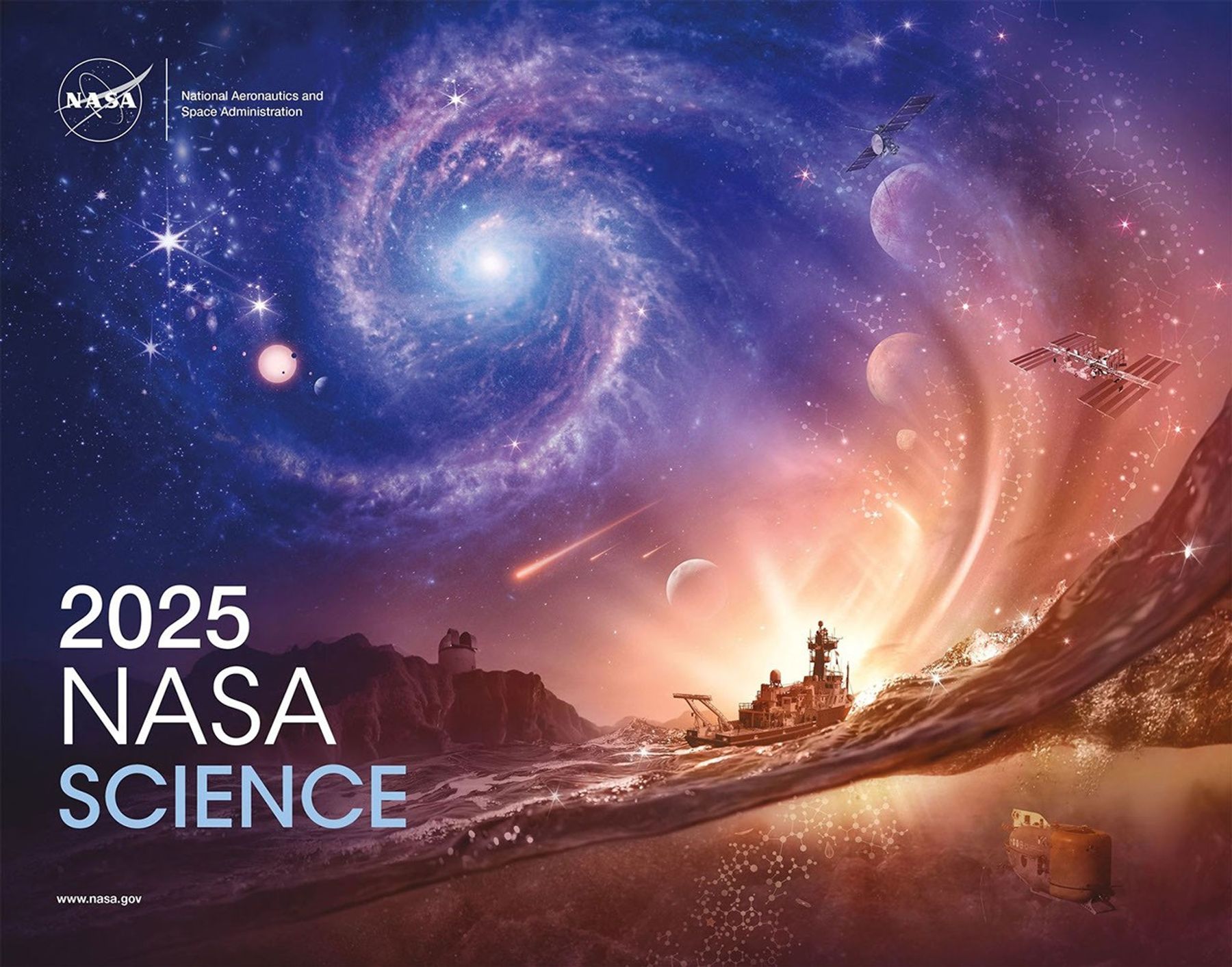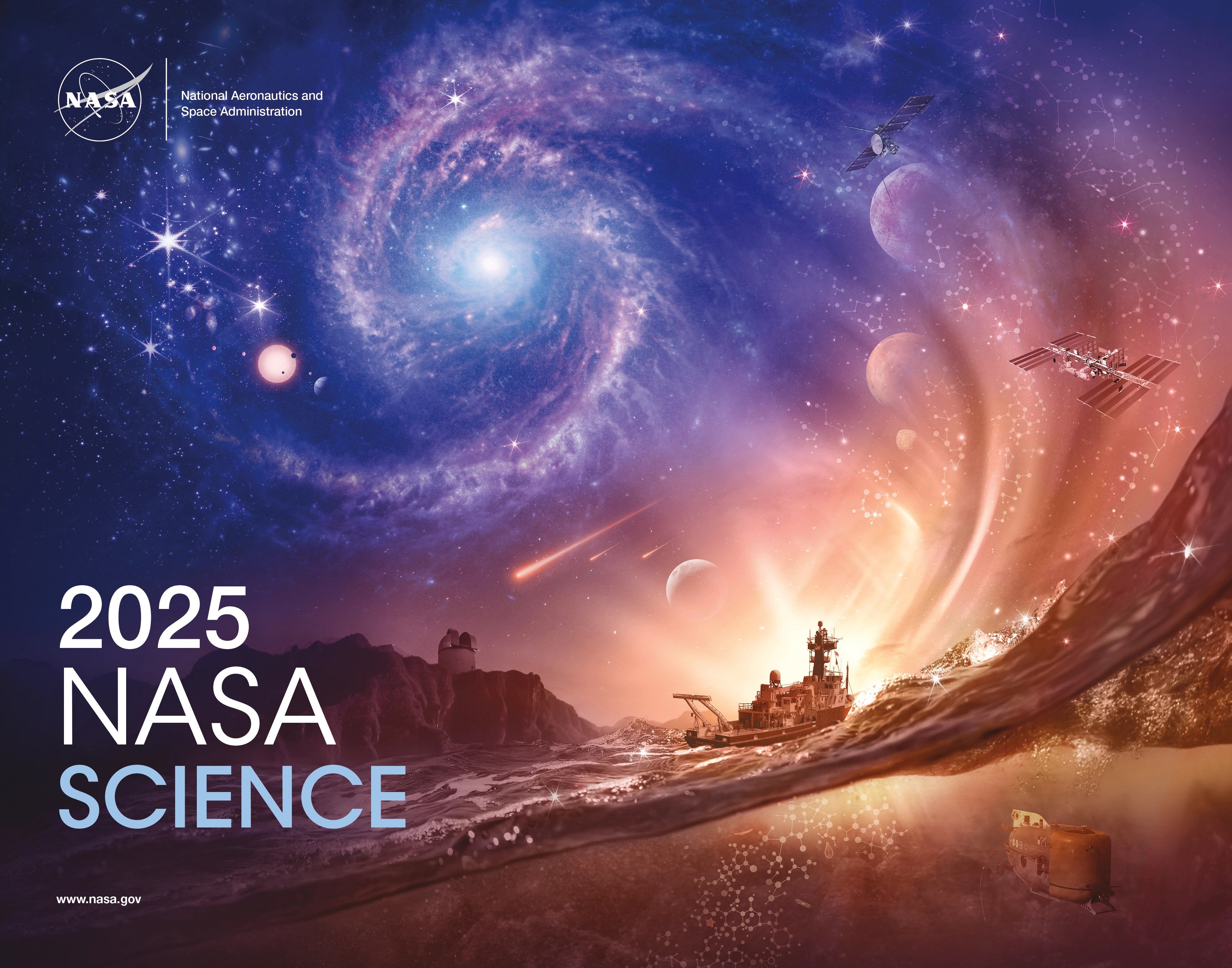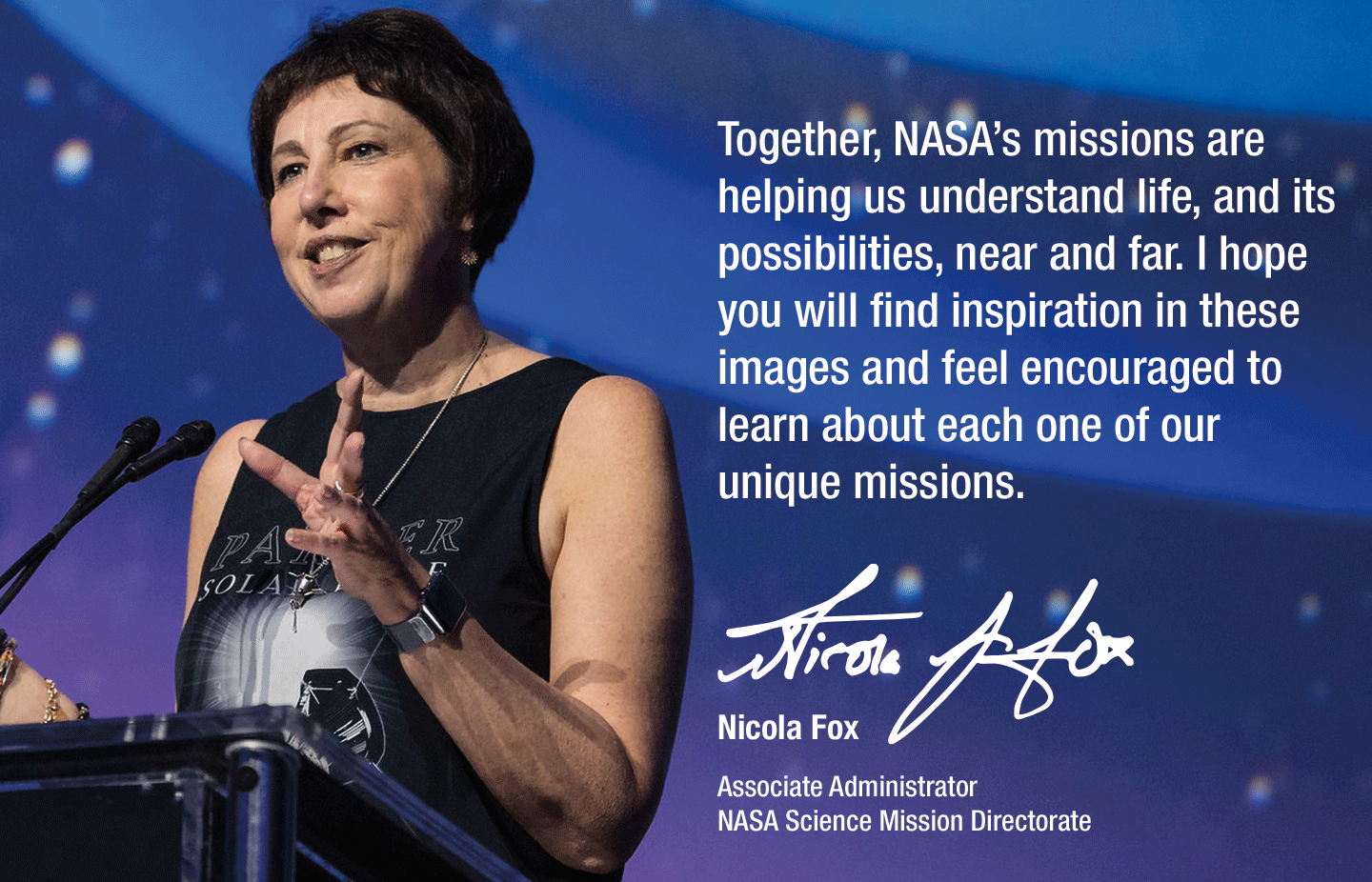Explore with us
2025 NASA Science Calendar
Welcome to the 2025 NASA Science Calendar! Download our latest calendar and wallpaper backgrounds for your desktop or mobile device, and discover the fascinating science behind the images featured each month.
2025 Calendar Download Options
2025 NASA Science Images
-
January - Aurorasaurus Citizen Scientist Captures Brilliant Photo of Aurora.
The strongest geomagnetic storm in over two decades dazzled scientists and skywatchers in May 2024. Overnight on May 10–11, an extreme storm culminated in a remarkable display of the aurora that was visible from many areas worldwide, including latitudes where aurora sightings are uncommon.
Photo and text credit: Photo by Aurorasaurus ambassador Gunjan Sinha; text by NASA Earth Observatory/Kathryn Hansen
-
February - NASA’s Lucy Observes First Contact Binary Orbiting Asteroid
On its journey to the never-before-visited Trojan asteroids that share an orbit around the Sun with Jupiter, NASA’s Lucy spacecraft made a remarkable discovery during a flyby in the main asteroid belt—the first contact binary celestial body, or satellite, seen orbiting a larger asteroid. On November 1, 2023, during Lucy’s planned encounter with asteroid Dinkinesh, the spacecraft spotted the larger asteroid’s satellite, later named Selam.
Image and text credit: NASA/Goddard Space Flight Center/Southwest Research Institute (SwRI)/National Science Foundation National Optical-Infrared Astronomy Research Laboratory (NOIRLab)
-
March - Studying Biological Impacts of Space Radiation
As NASA prepares to return to the Moon, it is important to study the impacts of space radiation and other spaceflight hazards on the human body. To do that, researchers developed human brain models in the lab and exposed them to simulated space radiation.
Image and text credit: Estrella Passerat de la Chapelle, Blue Marble Space Institute of Science, and Egle Cekanaviciute, NASA’s Ames Research Center
-
April - Air and Ocean Views
NASA’s Plankton, Aerosol, Cloud, ocean Ecosystem (PACE) satellite, launched on February 8, 2024, collects data on microscopic life in the ocean and particles in the air, advancing researchers’ understanding of issues including fisheries' health, harmful algal blooms, air pollution, and wildfire smoke. With PACE, scientists also investigate how the ocean and atmosphere interact with each other and are affected by a changing climate.
Image and text credit: NASA’s Goddard Space Flight Center/PACE; Image processing: Carina Poulin
-
May - Cool as Ice
Every winter, a layer of carbon dioxide frost (dry ice) forms on the surface of Mars. At its greatest extent in midwinter, this frost reaches from the poles down to the middle latitudes, until it is too warm and sunny to persist. In most places, this is around 50 degrees latitude, similar to the latitude of southern Canada on Earth. However, small patches of dry ice are found closer to the equator on pole-facing slopes, which are colder because they receive less sunlight.
Image and text credit: NASA/Jet Propulsion Laboratory (JPL)–Caltech/University of Arizona
-
June - NASA Telescopes Chase Down “Green Monster” in Star’s Debris
For the first time, astronomers have combined data from NASA’s Chandra X-ray Observatory and James Webb Space Telescope to study the well-known supernova remnant Cassiopeia A (Cas A). This work has helped explain an unusual structure in the debris from the destroyed star called the “Green Monster,” first discovered in Webb data in April 2023.
Image and text credit: X-ray: NASA/Chandra X-ray Center (CXC)/Smithsonian Astrophysical Observatory (SAO); Optical: NASA/European Space Agency (ESA)/Space Telescope Science Institute (STScI); Infrared (IR): NASA/ESA/Canadian Space Agency (CSA)/STScI/Milisavljevic et al., NASA/Jet Propulsion Laboratory (JPL)–Caltech; Image processing: NASA/CXC/SAO/J. Schmidt and K. Arcand
-
July - NASA-NOAA Satellite Observes Large Solar Eruption
The Solar Ultraviolet Imager (SUVI) instrument aboard the Geostationary Operational Environmental Satellites (GOES) West satellite observed a flurry of solar activity in mid-December 2023. This December 11 image from the SUVI 304A channel corresponds to plasma in the upper chromosphere of the Sun at a temperature of about 6,000 kelvins.
Image and text credit: NOAA/Cooperative Institute for Research in Environmental Sciences (CIRES)
-
August - Webb and Hubble’s Views of Spiral Galaxy NGC 628
This face-on view of spiral galaxy NGC 628 is split diagonally, showing observations from the James Webb Space Telescope (JWST) in the top left portion of the image and Hubble Space Telescope (HST) in the bottom right portion. JWST’s observations combine near- and mid-infrared light, while HST’s observations showcase visible light.
Image and text credit: NASA, European Space Agency (ESA), Canadian Space Agency (CSA), Space Telescope Science Institute (STScI), Janice Lee (STScI), Thomas Williams (University of Oxford), Physics at High Angular resolution in Nearby GalaxieS (PHANGS) Team
-
September - Thinning Arctic Sea Ice
Sea ice is frozen seawater that floats in the ocean. This photo, taken from NASA’s Gulfstream V Research Aircraft on July 21, 2022, shows Arctic sea ice in the Lincoln Sea north of Greenland.
Image and text credit: NASA’s Goddard Space Flight Center/ICESat-2/Rachel Tilling
-
October - The Sharpest Pictures of Jupiter’s Volcanic Moon Io in a Generation
During its close flyby of Jupiter’s moon Io on December 30, 2023, NASA’s Juno spacecraft captured some of the most detailed imagery ever of Io’s volcanic surface. In this image, taken by the JunoCam instrument from about 930 miles (1,500 kilometers) above the moon, Io’s night side [left lobe] is illuminated by “Jupitershine,” which is sunlight reflected from the planet’s surface.
Image and text credit: NASA/Jet Propulsion Laboratory–Caltech/Southwest Research Institute (SwRI)/Malin Space Science Systems (MSSS). Image processing: Emma Wälimäki © CC BY
-
November - Solar System Parallelism Inside a Solder Bead
Soldering is an essential manufacturing step for joining electrical conductors. It involves the melting and solidification of materials, which can result in voids and shrinkage during the process.
Image and text credit: Iowa State University/Manish Kumar and Siddhartha Pathak
-
December - Spritacular Citizen Scientist Captures Photo of Elusive Upper Atmospheric Electrical Phenomena Over Château de Beynac
A flash of lightning, and then—something else. High above a storm, a crimson figure blinks in and out of existence. If you see it, you are a lucky witness of a sprite, one of the least-understood electrical phenomena in Earth’s upper atmosphere.
Photo and text credit: Photo by NASA’s Spritacular project participant Nicolas Escurat; text by Miles Hatfield
































